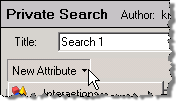- Contents
Interaction Recorder Client for IC Business Manager Help
Adding Attributes to a Search
After you have created a Public or Private search, use the SearchBuilder control, displayed in the Workspace, to add and configure attributes in your search. To display SearchBuilder in the Workspace, select a search in the Searches pane. The search is displayed in the Workspace, and the SearchBuilder is displayed with the New Attribute drop-down list.

Click New Attribute, to select the attributes to include in your search.
To select an attribute, point to the type of attribute you want to add to your search, and the available attributes are displayed in a submenu. Simple and rich attributes can be added to your search. Sub-instances can be added to a simple attribute, and rich attributes contain multiple sub-fields.
For a detailed description of all available attributes, see Recording Search Attributes and Scorecard Search Attributes.
Adding Attributes to a Search
Use the SearchBuilder control to select attributes to add to your search. To add an attribute to a search:
-
In the New Attribute drop-down list, point to the type of attribute you want to include. A submenu is displayed with a list of available attributes for the type you have selected.
-
In the submenu, click the attribute. The attribute control is added to the Workspace.
An attribute might be a simple attribute or a rich attribute. A simple attribute contains an operator and a field value that can be a string, list, or numeric type value. A rich attribute contains multiple sub-fields.
To configure a simple attribute:
-
In the SearchBuilder control on the Workspace, select the attribute. A highlighted selection rectangle appears around the attribute control to indicate it is the active attribute.
-
Select the operator for the attribute
-
Configure the values for the attribute
To configure a rich attribute:
-
In the SearchBuilder control on the Workspace, select the attribute. A highlighted selection rectangle appears around the attribute control to indicate it is the active attribute.
-
Depending on the type of rich attribute you selected, configure the operator values.
Attributes within the search are logically AND'd together. You can add in a UNION operator in-between attributes. To do this, right-click in the Workspace, and click UNION Operator.
Arranging attributes within a search attribute
Use the Up and Down buttons  to prioritize the order in which the attributes and unions should be considered when running the search. These controls are also available on the right-click shortcut menu.
to prioritize the order in which the attributes and unions should be considered when running the search. These controls are also available on the right-click shortcut menu.
Deleting an attribute from the search
Use the Delete button  to remove an attribute from the search. Delete is also available from the right-click shortcut menu.
to remove an attribute from the search. Delete is also available from the right-click shortcut menu.
Adding sub-instances to a simple attribute
When a simple attribute has been added to the Workspace, the Add More button ![]() is displayed in the upper right corner of the attribute control. To add an additional sub-instance of the attribute:
is displayed in the upper right corner of the attribute control. To add an additional sub-instance of the attribute:
-
First, in the SearchBuilder control on the Workspace, select the attribute. A highlighted selection rectangle appears around the attribute control to indicate it is the active attribute, and the Add More
 button is displayed.
button is displayed. -
Click Add More
 . The attribute sub-instance is nested within the parent control, with an additional operator and field value control.
. The attribute sub-instance is nested within the parent control, with an additional operator and field value control.
Note After you have added the number of sub-instances allowed by the attribute, the ![]() is no longer displayed as an option. For example, Direction has four available attributes: Inbound , Intercom, Outbound, and Unknown. After three sub-instances have been added to the original attribute, the Add More icon is no longer displayed.
is no longer displayed as an option. For example, Direction has four available attributes: Inbound , Intercom, Outbound, and Unknown. After three sub-instances have been added to the original attribute, the Add More icon is no longer displayed.
Deleting sub-instances from a simple attribute
When more than one sub-instance is included in a simple attribute, the Delete More button ![]() is available to the right of the active sub-instance, allowing you to delete the sub-instance. To do this:
is available to the right of the active sub-instance, allowing you to delete the sub-instance. To do this:
-
In the SearchBuilder control on the Workspace, in the attribute, select the sub-instance. The Delete More button
 is displayed next to the sub-instance.
is displayed next to the sub-instance. -
Click Delete More
 . The sub-instance is removed from the attribute.
. The sub-instance is removed from the attribute.





